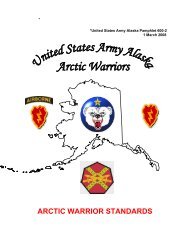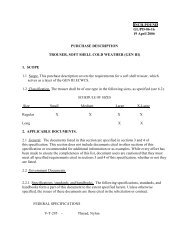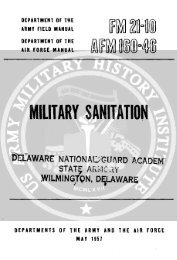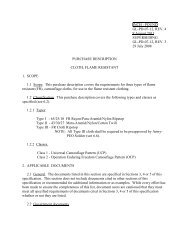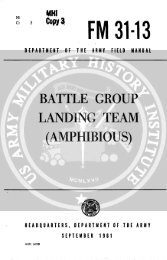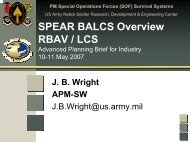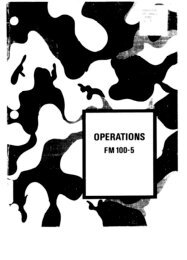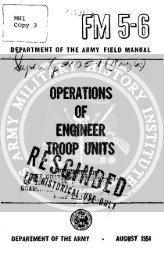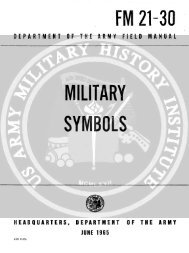11 - CIE Hub
11 - CIE Hub
11 - CIE Hub
- No tags were found...
Create successful ePaper yourself
Turn your PDF publications into a flip-book with our unique Google optimized e-Paper software.
~!;I::'"YOUR INDIVIDUAL FlpHTING L:pAD CARRIERS,Your fighting load equipmentitems (See Figure 2):is made up of the follow,ingCD 1 each Belt, Individual Equipment (size - Medium or!-arge)@ 2 each Case, Small Arms Ammunition (3D-Rd Mag)0 1 each Suspenders, Belt, Individual Equipment@)'1 each Carrier, Intrench'ing Tool, Plastic@ 1 each Cover, Canteen (1 Quart)@ 1 each Case, Field First Aid Dressing/Unmountednetic CompassMagThis instruction manual describes and illustrates the latestQ!standard carriers. However, 'any of the following M-56.componentscan be used together with the new items until suppliesare exhausted.Belt, Individual EquipmentSuspenders, Belt, IndividualEquipmentCase, Ammunition (2D-RdMag, M-14)Case, Ammunition (2D-Rd Mag, M-16)Case, First Aid/CompassCover, CanteenCarrier, Intrenching Tool (for use with wOQden handle intrenchingtool only)Pack, CombatIllustrations are shown where attachlT,)ent of the olderequ ipment is different.m6NOTE: The new Lightweight Pack Frame, Shoulder Straps andMedium and Large Packs are not interchangeable with any componentsof the Tropical flucksack or the Lightweigh t Rucksack withFrame. Either of these Rucksacks, however, may be worn togetherwith the new fighting load carriers.si9\1re 2. F.ightlngLoad Carriers7
...ASSEMBLING YOUR FIGHTINGLOAD CARRIEJtSI ' ,ADJUSTING YOUR EQUIPMENT BELT (Figure 3)METALKEEPERSADJUSTINGCLAMPFirst, try on the belt for size. It should be comfortablysnug- not tight. To adjust the belt so that it will fit:.....~~CD Push the two metal keepers between the adjustingclamp and the belt buckle towards the buckle.@ Unlock the adjusting clamp by spreading the loopedwebbing apart. .,@END OF BELT WHILEADJUSTING~ ~CD@ Slide the clamp towards the belt buckle to loosen or.away from the buckle to righten.'@ Squeeze the adjusting clamp to lock it in place.@ Move the metal keepers so' that one is next to the adjustingclamp and the other is next to the buckle.@.. .- r ' II0 00(END OF BELT AFTER ADJUSTMENT(i) 'i) @@ Adjust the other end of the belt the same way. Bothclamps should be about the same distance from thebuckle.Yowr belt is now ready for attaching the equipment ontoit.Figure 3. Adjusting the Carrier BeltIt819
"--~ ~~ ~ATTACHING THE AMMUNITION(Figure 4)CASES TO YOUR BELTAttach a case, using the two sli,dekeepers on the back ofit, one case to the left and one to the right side of the beltclose to the belt buckle by:POSITION OF AMMOCASES ON BELTi!!'..OPEN'POSITIONOFSLIDE KEEPERSCD Pulling each keeper up to its open position and slidingthem over ONLY one thickness of webbing. Make surethe keepers are vertical and the bottoms are out beyondthe webbing.~,LOCKED POSITION OFSLI DE KEEPERS@ Pushing the s,lides of the keepers down and"'into thebottom holes.@ M'aking sure you push the slides firmly into the holes,otherwise the slide will be in the WRONG position asshown in the sketch, and the equipment could fall off.SLIDEKEEPERS 4'.0 Pockets for carrying fragmentation hand grenades areon eachsideof the ammocases. Besure,after puttingthem in, that the nyl'on strap gois through the ,ring andis snap fastened as shown in the ske,tch.@ If, you have 20-round magazine cases for the M-14orM-16rifle, the sketch in the block on Figure 5 showsthe way to attach them.~ SllOES~~~~;OINTOIIIII <strong>11</strong> ,~fj\ WRONG '" 'RIGHT\V 'X~ i",GRENADE1L-' ,fPOCKET /~!~\ '.fi,igu~e4. Attaching Ammunition..Cases to Your Belt10 ~ 1
fl'II:IiATTACHINGTHE SUSPENDERSTO THE AMMUNITIONCASESAND BELT (Figure 5)I"!\CD Snap hooks for attaching the suspenders to the belts areopened by pushing the hook up and out of the side retainingclosure. When the hook is engaged into eyelets,snap it back into its closed position.@ Attach the back suspender strap hooks into eyelets(top row of belt) located to the right a",d left of theeyelet centrally located on the back of the equipmentbelt., ~(]) Attach the front suspender strap hooks to the strap supporteyelet located on top back of ammunition case.~. 0)\ IPUSH UPTO OPENPUSH DOWN.TO CLOSE0 Web and metal loops are provided on each shoulderstrap to which smallitems (first aid/compass case, flashlight)can be attached.@ The elastic Ibops on each of the adjustment straps areused to secure the loose ends of the straps after adjustment.ATTACHING M-14 ORM-16 AMMO CASESWhen ammo cases are not used, the front suspenderstraps are attached to the eyelets on either side of thebelt buckle.@ If M-14 or M.16 ammo cases are used, attach to the suspenders,as shown in the sketch.f.igurei5. Attaching Suspenders to Ammunition Cases and Belt.1213
IT' -.., , - ~ -.........>IfIiADJUSTING THE FRONT AND BACK SUSPENDERSTRAPS (Figure 7)-- .YOKE-~u,After the equipment is attached to the belt and suspenders,put it on./ CD Fasten the belt buckle.. JI .I ,gJ.,. ,Adjust the length of the back and front straps so thatthe belt hangs evenly in the desired position at the waist by;@ Pulling down on the loose end of the strap to tightenor lifting the end of the buckle to loosen the strap.'"u'~II'rll(]) After the belt is in the best position around your waist,secure the loose ends of the straps with the elastic loops.@ The adjustment of the back strap is made the same waybut it is best done with the help ofllnother person tomake the adjustment.@ Care should be taken in adjusting the straps so that notonly does the b~lt hang at the proper waist level butthat the yoke is positioned for your maximum comfort.(figure 7. Adjusting Suspender Straps.1617
~IIiiIi1< ", ,YOUR"INDI\/IDUAL EXISTENCE bOAD OARRIERS" \1'Your existence load carriers consist ofIt he following ite;ms(see Figure 8):1:iIj1 each Frame, PacK, Ground Troops2 1 each "', Strap, Lowe",r Back3 1 each Strap, Waist~ ',Ii4 1 each Strap, Shoulder'f without Quick Release5 1 each Strap, Shoulder, with Quick Releasei~,;II,6 1 each Shelf, Cargo SURlJOr17 2 each Strap, Cargo 1i~bown r,I'8 1 each Pack, Combat; Me~ium9 1 each Pack, Comba~ Large ,0) 1 each Cover, Field Pack"PalTlouflage (for either Mediumor Large Pack) <strong>11</strong><strong>11</strong>II'I!iil'ii;iii,I.~II'tl ,Il'}tJIII
~,~~ ~,.,--- - ~~ ~'Ir:l:J IIATTACHING THE SHouLDER STRAPS ,JM(FiQure10)'!!I':,~,I~On'e strap is for your right shoulder, the other, with thequick release assemblY is for your left shoulder. The quick"'. . . "~.'" ..rele,ase assembly is 'described later in this, I :I.manuaL .. ,IIIITo attach the straps,to the frame: ""CD Insert the looped en~ ofirthe strap {rom,jthe IN~IDE ofthe frame through the nylon ring at the bottom side,thread the strap through ", the . loop, and pull tight.0 Insert the webbin~"at themtop of your strap through themetal keeper on the .lop of the frame, through thebuckle, and pull tight. 1he padded end of the strCiPshould normally be under the frame bar.gaJ1"IJ:QUICK RELEASETAB ON WAIST STRAPATTACHING THE WAIST STRAPSLike the shoulder straps,}he waist straps also are made with~ quick release assembly. Jhe pull tab is shown on the strapassembled to the frame. Ati'ach the strap with the pull tab,either on the left or right of the frame depending on whichhand you use to pull it open.!I'ASSEMBLED FRAME AND S'iFfilAPSTHREAD WHOLESTRAP THROUGHLOOPTo atta~h the strap:\Utill22@ Insert the looped end of the waist strap around thelower'part of the frame as shown and pull tight.Figure 10. Attaching Shoulder and Waist Straps to Pack Frame23
-ATTACHING THE CARGO SHELF AND CARGO TO THEFRAME (Figure <strong>11</strong>)The cargo shelf is very simply slipped onto either th~ middleor bottom of the back of the frame as shown in Figure<strong>11</strong>, sketch A. It is used to support such loads as five-gallonwater or gas cans, cases of ammunition, field rations, radio,or other bulky items.A load is shown partially tied to the frame with the cargotie down straps (Figure <strong>11</strong>, sketch S.) Two are furnished witheach issue.The tie down strap buckle is made for a very secure hold ofthe load to the frame. Proper adjustment, however, is important.The top strap shown in Figure <strong>11</strong>, sketch S, is wrappedaround the load and frame but not pulled tight. To securethe load, the hooked end should first be inserted in the buckleas shown in sketch C and the loose end pulled in the directionof the arrow for a fairly tight hold, but leavingsome slack.The fastener isthen pushed into the closed position, shown insketch D,which willtake up the slackthat was left. If enoughslackisnot left before closing the fastener, closing it will puttoo much tension on the strap so that it will not fully close, orif the load is contained in a soft container, the closed strapmay crush the contents.To release, pull up on the end of the strap to open thefastener.'~:-~:.\:~:.~:".' ?",0 -
AbJUSTING(Figure 12)THE SHOULDER AND WAIST STRAPSYour shoulder and waist straps have adjustment bucklesthat are used after the straps are attached to the loads and youhave the straps and load over your shoulder.~To adjust the shoulder straps to either lift or lower theload on your back:CD Pull down on the loose end of tlte webbing to shortellthe strap. To lengthen it or to loosen it for slipping offthe load easily. pull up on the cords.TO LOOSENSTRAPTo adjust the waist straps:
1~~IMEDIUM PACK The medium pack is most commonly carried using theshoulder straps without the frame. When required, the packGENERAL DESCRIPTION(Figure 13)can be attached to the frame and shoulder straps in the sameThe medium pack, designed to carry up to 50 pounds ofway as is shown later for attaching the large pack to the.frame.various existence load items, is the one generally used bymost combat troops. Figure 13 shows front and back views.The pack is water repellent but not waterprodf,. Four waterproofliners are issued with each pack; one large one for themain compartment and three small ones for each of thethree pockets. Equipment to be carried should first be insertedin the waterproof liners, then into the main compartmentand pockets. Instructions for making a water-tightclosure are printed on the outside of each liner.MAIN COMPARTMENTCLOSING BUCKLEIIThe small pocket in the main compartmentcarry the AN/PRC-25 or AN/PRC-77 radio.can be used toThe main flap for covering the loaded pack can be openedby pulling apart the two tabs. The camouflage cover or othersmall flat objects can be stored in it. Simply pressing theflap together seals it.FRONT,. - -Equipment hangers (webbed loops and webbing with eyelets)for use with slidekeepers and/or hooks are provided onthe sides of the pack and above the pockets for carryingequipment on the outside of the ,pack.For carrying equipment such as a bayonet scabbard ormachete sheath, the pockets are tunneled between the pocketsand main compartment. By sliding the piece downthrough the tunnel, it can be fastened to the hanger above itwith slidekeepers or hooks.BACKFigure 13. Front and Back Views of Medium Pack28 ~Q
CLOSING THE LOADED PACK (Figure 14)Once your pack is loaded, close and tighten as follows:Secure the contents of,the pocket in the upper part of themain compartment by threading the tape through the buckleand pull tight.CD Close the top of the pack by using the drawstring buckle.Pull the two cord ends as shown to gather the top intoa tight closure.~,\ 0 \CLOSED PACK0 To loosen the drawstring, push the button on the buckl.eup with your thumb and pull down.@ each pocket is closed by threading the webbing throughthe buckle and pulling tight. For ease of opening apocket, unsnap the lower end of the tie down. Thiswill let you close the pocket again without threadingthe webbing through the buckle.Insert the main flap tie down straps through the webbedloops on top of the main flap, pull down over the pack throughthe bottom buckles. and pull tight.SNAPBOTTOMSON POCKETCLOSINGSTRAPSFigure 14. Buckles for Closing and Opening Pocket Flapsand Main Compartments30,.\- -- - --31
TATTACHINGTHESHOULDERSTRAPSTO THEMEDIUMPACK(Figure 15)METAL LOOP ATTOP OF PACKThe medium pack is often carried using the shoulder strapswithout the pack frame as shown in Figure 15.To attach the straps to the pack use the same procedureas used in attaching the straps to the frame, that is:
.!,l.1'" ATTACHINGYOUR BEDROll (Figure 16) LARGE PACK,:II'\:vi M !,Ii,iThE)bedroll san be"Carried inside the pack or a,ttached tothe outside. Figure 16 shows one way of carrying it by at;~taching it to bottom of th,~ medium pack with two cargostrapsi!Pulledt~rough "' the loops on the bottom of the pack.'",«'GENERAL DESCRIPTION (Figure 17)"The large pack is a specialpurpose pack used to carry excessivelylarge loads (up to 70 pounds) that would be requiredfor Arctic or other special missions. It is much the same as themediumKpack except for its larger size'imd three more smallpockets at the top. There are tie-down cords and "D" ringsinside the main compartment to shorten ,the pack if it is notfilled to capacity. The three lower pockets are tunneled toqllow the carrying of skis and other equipment, and they havecoras at the top for better sealing of the pocket before closingthe flap.( , ,"'It is recommendedthe frame.that the large pack always be carried on'ill!Figure 16. Bedroll Attached to Medium PackFigure 17. Front and Back Views of Large Pack34315
'~" 'II','ATTACHING THE LARGE PACK TO THE FRAME(Figure 18)-~~Figure 18 shows the large pack on the pack frame.tach it:To at.CD Insert the bare frame into'thethe pack.envelope on the back of0 Secure the bottom of the pack to the frame as shown.Note that the webbing is looped'around the frameTWICE before buckling. Attach the shoulder straps anawaist straps as previously described.Figure 18. Attaching the Large Pack to the Frame36 :1'1ill-I. .<strong>11</strong>
;:-101'"QUICK RELEASES (Figure 1~)In emergency situations when sudden removal of yourback pack is required, quick releases are provided on the leftshoulder strap and the waist strap.Steps (Dthrough@)of Figure 19 show how the shoulderstrap quick release is assembled. The metal loop .at the top ofthe lower end of the strapG) is hooked over the metal loop@. The plastic prongs@are pushed down through so thatthe locked assembly is as shown in@"Steps@through@of Figure 19 shows how to assemble,the quick release on the waist strap.SHOULDER STRAPQUICK RELEASE~I~"" I~ 0."'..""5. ':..1For sudden release FIRST pull the tab on the waist strap@and follow immediately by pulling up on the tab on theshoulder strap@ Shift the load toward your right and letit slip off your right shoulder.~~. '-:~-'; CD~WAIST STRAP QUICK RELEASESFigure 19. Shoulder Strap and Waist Strap Quick Release.138 '1U
-,.CLEANINGAND MAINTENANCEWater repellent treated nylon duck and webbing was usedto fabricate all of the fabric items of equipment. The IntrenchingTool Carrier is molded of ethylene-vinyl acetate. ThePack Frame and Cargo Shelf are fabricated from aluminumwith solid steel rivets in certain high stress areas. ~The equipment can be cleaned by removing mud or otherforeign matter with brush, damp or dry cloth, or by scrubbingthe exceedingly dirty areas utilizing the following procedure:"Field Expedient" maintenance will be limited to the reopair of damaged or loose stitching by hand sewing,or topingand replacement of damagedor missingkeeperson suspenders,small arms ammunition case, field first aid dressingcase, In.trenching tool carrier and water canteen cover. Maintenanceabove user levelwill be in accordance with TM 1o-84()().201.23.,/I1. Scrape dirt or mud from the equipment using a flat stickor a dull instrument which will not cut the fabric orwebbing.2. Remove loose dirt from soiled surfaces using a cloth orsoft brush.3. Wet out the surface and apply a warm solution of Detergent,Laundry, Powdered, MIL-D-12182, Type II (FSN7930-252-6797). Scrub with soft brush, cloth, orsponge.4. Flush the item thoroughly with clean, warm water untilall the cleaning solution has been rinsed away.5. Dry the item or equipment away from direct sunlight,direct heat and open flames."~40 -- ~,."" ~



